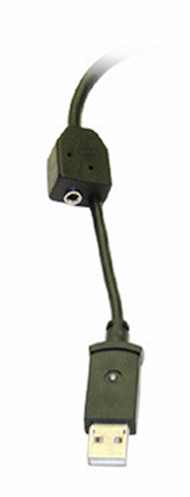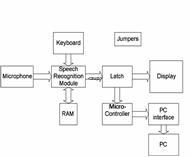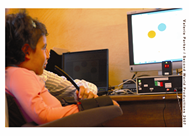Voice Control System: A Language Independent Voice Control System for a PC Mouse, Telephone, and Toys
Michael Darish
University of Massachusetts
Electrical and Computer Engineering Department
Lowell, Massachusetts 01854
ABSTRACT
Persons with Paraplegia who have vocal ability can benefit from voice recognition devices that would allow them to interact with and control their environment. Many such persons, especially the young, those on ventilators, and user’s who cannot read, may find commercially available voice recognition solutions difficult to train and use. One difficulty is due to the need for reading a prepared text out loud for 15 or more minutes to train the software to recognize words. Another difficulty arises when a user does not speak English, as many of the current devices only recognize English and a limited selection of other languages. Also, various commercially available voice recognition products rely on a dedicated desktop computer making their use expensive and difficult to move. This paper describes the design and development of the Voice Control System (VCS) which is easy to train and use, small, stand-alone, portable and is language independent.
KEYWORDS
voice control; voice recognition; assistive technology; paraplegia; PC Mouse
BACKGROUND
The Voice Control System (VCS) was designed and developed for a five year old girl in Italy after receiving a request from her father. The girl has paraplegia due to a car accident and was limited in what she could do for herself. The girl needed the ability to accurately control the PC mouse so she could do homework when she entered school. The father searched all over but could not find an acceptable PC mouse (mouse) click, drag, and drop control solution and asked if it was possible to design a system which would use her voice. The father mentioned that he had a solution for moving the cursor around the screen with a device named Tracker Pro, but it did not meet his daughter’s requirements for school assignments.
PROBLEM STATEMENT
The main request was to develop a voice control method for the PC mouse click, drag, and drop functions that would work with the USB interface shown in Figure 1.
The first requirement was that the device had to be easy to learn. Another was that the device had to be language independent, since the girl only spoke Italian. A third requirement was that the device needed to be designed for use in and with the European power system. Also, with the fathers permission, additional functions were explored which increased project complexity and issues. Those functions included the use of the telephone and control of some toys.
DESIGN DEVELOPMENT
Initial Design
The Voice Control System (VCS) criteria were established and an initial functional block diagram was developed providing an overview of how the device would work.
Due to the language limitation of most single chip voice recognition devices found, it was determined that a language independent solution made from discrete components was the most viable option.
Since all peripheral device development depended on the selection of the voice recognition chip, it was the first part to be determined. Research indicated that a voice recognition chip manufactured by HMC along with its associated memory chip would be an excellent choice. Next, a keyboard, microphone, and display were chosen. The design continued with the development of an initial electrical schematic and building of a voice recognition evaluation circuit.
Once the voice recognition circuit was working properly, the control circuitry was designed. A micro-controller was chosen as the main Input / Output device due to its ease of implementation and availability. A preliminary control circuit schematic was developed and an evaluation circuit was built. Next, a software flow diagram was developed to indicate how the software would work and control the various functions. The software was then written following the flow diagram as a template.
Due to the very low signal strength of the voice, it was imperative to keep the signal to background noise ratio (SNR) low so it would not cause device performance issues.
Additional functions were added which included a telephone and three toys like the standard single switch control toys found in adaptive toy catalogs.
Technical Description
The main enclosure is a plastic chassis and houses the core of the system which is comprised of two boards.
The first board is the Voice Recognition Board (VRB) where the voice signal enters the device via a microphone and is processed before being sent to the memory for storage.
The second board is the Input / Output Control Board (CIO) where the codes stored in memory are routed to the microcontroller. Software within the microcontroller determines the appropriate output control relay(s) to turn on, which in turn activates the desired function.
The keyboard on the top of the enclosure provides the means to enter codes which are used to either clear or program a memory location corresponding to a specific function. A two digit hexadecimal display, also on the enclosure top, provides visual confirmation of trained and recognized function codes. Since the user was expected to be in a wheel chair most of the time, it was decided to mount the visual display vertically for easier viewing. A mouse direction control switch allows the left and right mouse click button functions to be reversed.
EVALUATION AND CONCLUSION
Delivery and operation of the Voice Control System was successful. This was evident by the little girl’s smiles and laughter as she used her voice along with a computer program to drag and drop colored balls into boxes. Additionally, as she turned on the toys, her display of joy and excitement further showed the success and usefulness of the device. The additional functions expand her ability to control her world by providing her with the capability to self-educate, to entertain, and to explore the world through internet access, making telephone calls, and turn on toys. The VCS provides her with a sense of freedom and control over her environment that she did not have before. This can only enhance the young girl’s quality of life.
Acknowledgements
Thanks to my parents for endowing me with an exceptional work ethic and the sense to do things correctly and well.
Thanks for the support of the National Science Foundation through the Engineering Senior Design Projects to Aid Persons with Disabilities program.
Also, I would like to thank Professors Alan Rux, Donn Clark, and Craig Armiento for their support and encouragement.
Author Contact Information
Michael Darish
500G Brookside Drive
Andover, MA 01810
(617) 571-8901
m_darish@yahoo.com


